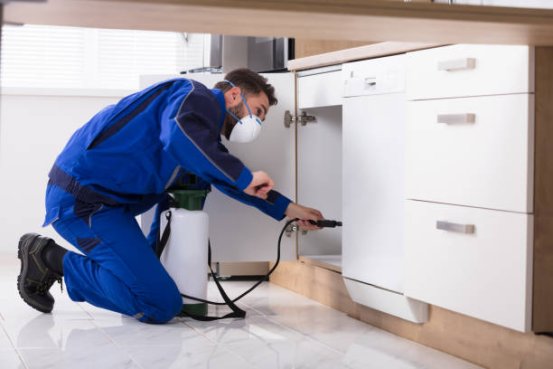Technology
Understanding Local Pest Control Services in the United States: Key Insights for 2025
Pest control approaches differ widely across U.S. regions. This guide examines how local expertise, service options, and pricing influence pest control in 2025, helping you choose the right provider.
Pest control approaches differ widely across U.S. regions. This guide examines how local expertise, service options, and pricing influence pest control in 2025, helping you choose the right provider.

What Local Pest Control Services Provide in 2025
Local pest control companies offer more than basic pest elimination. They combine advanced technology, customized treatment plans, and ongoing prevention strategies tailored to your area and common pests. Popular threats across the U.S. include termites, rodents, mosquitoes, ants, bed bugs, bees, and seasonal pests, each requiring specific treatment methods.
Typical offerings in 2025 include:
-
Customized Treatment Plans: Developed after assessing your home or facility to address local pest species and infestation severity.
-
Seasonal Pest Control: Programs designed for recurring seasonal pests, such as mosquitoes in summer.
-
Termite and Rodent Control: Specialized treatments for pests like termites and mice, often including monitoring and service guarantees.
-
Wildlife and Home Services: Some providers offer attic insulation, gutter protection, and wildlife exclusion to make properties pest-resistant.
-
Environmentally Responsible Solutions: Integrated Pest Management (IPM) methods prioritize minimal environmental impact and safe pesticide use.
Selecting the Right Pest Control Service
Consider these factors to ensure you choose a provider suited to your needs:
1. Local Expertise and Availability
Companies with local branches or service providers better address regional pests and climate challenges, offering flexible scheduling and prompt response for urgent infestations.
2. Experience and Licensing
Choose providers with sufficient experience and proper state certifications. Licensed technicians follow safety standards and legal guidelines, ensuring effective and safe treatments.
3. Transparent Pricing and Guarantees
Reputable providers offer upfront pricing or free inspections with customized quotes. Many guarantee results through off-schedule visits or money-back options if pests persist.
4. Range of Services
Look for companies offering diverse solutions—from one-time treatments to ongoing monitoring and prevention for both household and commercial properties.
5. Customer Feedback
Check reviews on BBB, Google, and Trustpilot. While national brands may have mixed ratings, local branches often show higher scores reflecting direct customer experiences.
Typical Residential Pest Control Costs
Costs vary by pest type, infestation severity, home size, and service frequency. General estimates for 2025 include:
-
Inspection Fees: Usually free or $125–$450 if charged.
-
One-Time Treatments: Typically $300–$550; larger or complex infestations may cost more.
-
Recurring Service Plans: Price depends on frequency and pest coverage.
-
Specialty Services: Termite, rodent, or wildlife treatments start around $250–$350 or higher.
Many companies provide preliminary phone estimates but confirm pricing after on-site inspection for accurate service customization.
Advantages of Professional Pest Control Over DIY
While DIY solutions may suffice for minor pests like ants or spiders, professional services are recommended for:
-
Large or Persistent Infestations: Termites, rodents, bed bugs, and venomous insects need specialized knowledge and commercial-grade treatments.
-
Safety: Professionals apply treatments with minimal risk to family, pets, and property.
-
Long-Term Prevention: Regular inspections and treatments reduce future infestations.
-
Accurate Pest Identification: Experts ensure correct identification and customized treatments.
Characteristics of Local Pest Control Providers in the U.S.
National companies often combine broad coverage with local expertise:
-
Orkin: Over a century of experience with termite, mosquito, and home services; adapts solutions to regional pest profiles and offers service guarantees.
-
Terminix: Offers customizable year-round plans for multiple pests, balancing service variety with affordability.
-
Rentokil: Focused on commercial services but also residential; annual PestFree365+ plans provide tailored protection.
-
Hawx: Smaller footprint, specializes in stinging insects and perimeter treatments, offering quarterly or bimonthly services with strong customer satisfaction.
These providers generally maintain positive BBB ratings and provide professional pest management for common and challenging infestations.
Final Tips for Choosing a Local Pest Control Provider
-
Start with a free or low-cost inspection for detailed assessment.
-
Request multiple quotes to compare services, guarantees, and prices.
-
Review current customer feedback in your region.
-
Verify licensing and certifications with state agencies.
-
Confirm eco-friendly or IPM treatment options if preferred.
-
Clarify follow-up services and contract terms before committing.
By evaluating local pest control providers using these guidelines, homeowners and businesses can make informed decisions in 2025 to maintain pest-free environments with professional support.
Sources
Medical Training Institute of New York - Medical Assistant Program
Medical Training Institute of New York - Dental Assistant Program
Thomas Jefferson University Health Sciences - Admissions
How do you like this article?




